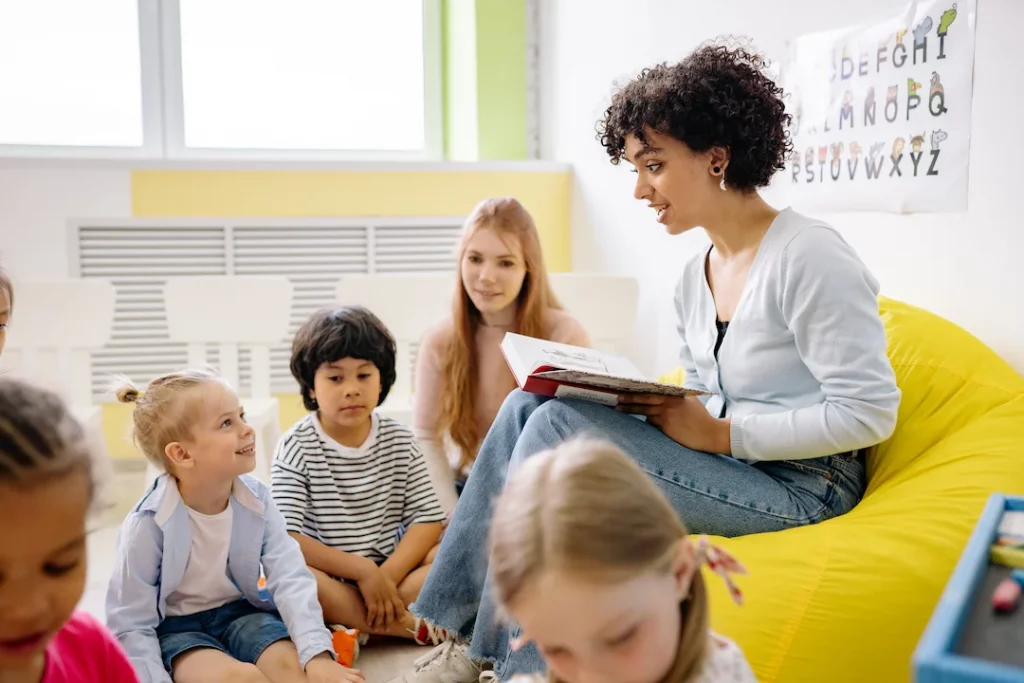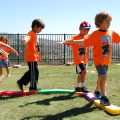In today’s interconnected world, being multilingual opens doors to new cultural experiences, fosters cognitive development, and enhances communication skills just to name a few. Our Raleigh preschool teachers are experts in preschooler language development and are exploring the rewarding journey of teaching Spanish to preschool children in this post. From uncovering its cultural purpose to the benefits of learning a new language, and ideas for incorporating Spanish language learning into daily activities, our Raleigh preschool has everything parents need to feel supported during this exciting time of language acquisition.
At Primary Beginnings, our early childhood educators understand that teaching Spanish to preschool children can seem daunting, but rest assured, we’re here to guide you through practical and enjoyable strategies to make it both fun and easy for your little learners.
The Value of Teaching Spanish to Preschool Children
Have you ever thought about learning a second language? What about teaching your child a second language? As it turns out, teaching your little one a second language, such as Spanish, at a young age is easier for them than having them learn a new language later in life. As toddlers are developing their language skills, they absorb anything and everything that they hear. This can have both positive and negative effects, so tread lightly!
Benefits of Teaching Your Child a Second Language
Here are some of the many benefits of parents teaching their preschooler a second language during this stage of their development:
- Learning a foreign language helps children understand their native language.
- Studying other languages can make children more flexible and abstract in their thinking.
- Kids who speak more than one language have a better understanding of others. Plus, they tend to have a greater cultural awareness and can avoid saying or doing offensive things.
- Learning a second language helps preschoolers enhance their problem-solving skills.
- Children who know a second language are better at paying attention, even with other stimuli going on around them.
- Knowing more than one language can give kids a sense of pride and accomplishment. This helps develop a much-needed sense of self-esteem at this young age.
- Last but not least, learning a new language is fun!
- Our preschool teachers make learning a new language fun by hosting a potluck that includes tasty food from other countries. We like to believe this helps curb picky eaters! We also encourage our preschoolers and kindergarten children to engage in cultural crafts, such as making a Japanese hand fan or Chinese lanterns!
Creating a Language-Rich Environment for Preschoolers
A language-rich environment is crucial for fostering language acquisition and fluency in preschoolers. By immersing children in a setting where they are surrounded by opportunities to hear, practice, and engage with the target language, you can significantly enhance their language learning experience.
Establish a Language Learning Atmosphere
One of the first things you should do before teaching Spanish to preschool children is to designate a learning environment that encourages your child to learn. Designate specific areas in your classroom or home where language learning takes place. This can be a cozy corner with pillows, rugs, and a collection of books in the target language. Creating a dedicated space sends a clear message to children that language learning is valued and provides them with a comfortable environment to explore and engage with the language.
Use Visual Aids and Props
Visual aids, such as posters, charts, and graphics, help preschoolers associate words with images and concepts. Display colorful and age-appropriate visuals that depict vocabulary related to everyday objects, animals, numbers, colors, and more. Incorporate props and real-life objects to make the language learning experience tangible and interactive. For example, use toy fruits and vegetables to teach names in the target language or hang up a world map to explore different countries and cultures.
Label the Environment
Label items in the classroom or your home with bilingual labels. This includes labeling objects, furniture, and areas with their corresponding words in the target language. Use clear and easily readable labels to reinforce vocabulary and help children make connections between the written word and its meaning. For example, label the door as “puerta” or the toy box as “caja de juguetes.” Learning by association will help your little one to learn quickly!
Integrate Language into Daily Routines
Infuse Spanish words and phrases into daily activities and routines. Use the target language during morning greetings, circle time, storytime, and transitions. Sing songs and chants in Spanish, recite rhymes or fingerplays, and encourage children to respond and interact using the language they are learning.
Activities to Teach Spanish to Preschool Children
Teaching Spanish to preschool children can be a fun and engaging experience with the right activities. Incorporating interactive and hands-on approaches helps capture children’s attention, promote language retention, and create a positive language learning environment to support the learning of English to Spanish for children.
Using Songs and Music for Spanish Language Acquisition
Songs and music are powerful tools for engaging preschoolers in language learning. They captivate children’s attention, promote active participation, and make the language acquisition process enjoyable.
Selecting catchy and age-appropriate Spanish songs is essential to capture preschoolers’ interest and maintain their engagement. Look for songs with clear pronunciation, repetitive lyrics, and catchy melodies. Choose songs that cover a range of vocabulary themes, such as numbers, colors, animals, greetings, and everyday activities. Incorporate a mix of traditional children’s songs and contemporary tunes to keep the learning experience diverse and exciting.
How Storytelling and Books Enhance Language Skills
Choosing age-appropriate Spanish storybooks is essential for engaging preschool-age children and supporting their language development. Select books with simple, clear language, vibrant illustrations, and topics that resonate with young learners.
Look for books that introduce basic vocabulary, repetitive phrases, and interactive elements that encourage participation. Matching the reading material to children’s language proficiency and interests ensures they stay engaged and motivated to learn.
Art and Craft Activities for Preschoolers Learning Spanish
Art projects offer a creative platform to reinforce vocabulary in a visual and tangible way. For example, you can create a collage using cut-out pictures from magazines or printed images related to a specific theme or vocabulary set. Encourage children to label the objects in Spanish as they glue them onto the collage. Additionally, you can have them draw and color scenes that depict vocabulary words, such as animals, food, or nature. This hands-on approach helps children make connections between words and visual representations, strengthening their vocabulary retention.
Games and Play for Teaching Spanish to Preschool Children
Games and play are highly effective methods for teaching Spanish to preschool children. They provide engaging and interactive experiences that make language learning fun and enjoyable.
Introduce age-appropriate language-learning games specifically designed to teach Spanish. These can include matching games, memory games, or bingo-style games with Spanish vocabulary words or phrases.
You can also use flashcards to play interactive games like “Go Fish” or “Memory Match,” where children practice vocabulary by finding matching pairs. These games encourage active participation and repetition, helping children reinforce vocabulary and language structures.
How Interactive Technology and Apps Can Support Your Efforts to Teach Spanish to Preschoolers
Interactive technology and apps can be valuable tools to support your efforts in teaching Spanish to preschoolers. They offer engaging and interactive experiences that enhance language learning and provide opportunities for independent practice.
Explore Spanish language learning apps specifically designed for preschoolers. Look for apps that provide age-appropriate content, interactive activities, and engaging visuals. Choose apps that focus on vocabulary building, pronunciation practice, listening comprehension, and basic language structures. Ensure that the apps offer clear audio recordings, visual cues, and interactive elements that encourage active participation and language use.
Engage in Cultural Experiences for Spanish Language Learning
Engaging in cultural experiences is a fantastic way to enrich Spanish language learning for preschoolers. By celebrating Spanish holidays and traditions, cooking a cuisine that’s popular in another country, and attending cultural events in the community, children can deepen their understanding of the language and embrace the vibrant diversity of Hispanic culture.
Introduce preschoolers to Spanish holidays such as Día de los Muertos (Day of the Dead), Las Posadas, or El Día de la Independencia (Independence Day). Teach them about the significance of these celebrations and engage them in related activities.
Introduce children to the rich flavors of Spanish cuisine by exploring traditional dishes. Teach them the names of popular foods like paella, empanadas, or churros. Engage children in simple cooking activities, such as making tortillas or preparing a fruit salad with Spanish fruits, all while encouraging the use of Spanish words and phrases.
Learning Spanish at Primary Beginnings Preschool in Raleigh
Primary Beginnings is proud to announce that we are now offering Spanish classes for our preschoolers. By implementing a foreign language program into our curriculum, we are adding new ways of enhancing the young minds at our child care center. Spanish classes will be offered on Tuesdays and Wednesdays to our 2-year-olds, 3-year-olds, and 4-year-olds.
Want Your Preschooler to Learn Spanish? Contact Primary Beginnings Today!
As it turns out, teaching Spanish to preschool students is fun and easy! Are you excited about the idea of your preschooler learning Spanish? At Primary Beginnings, our early childhood education programs encompass the power of early language acquisition and the benefits it provides for children’s cognitive and cultural development. Our dedicated team of educators is passionate about creating a language-rich environment where your child can thrive.
By enrolling your child at Primary Beginnings, you’re giving them the opportunity to embark on a language-learning journey that will shape their future.
Primary Beginnings has available spots for infants, toddlers, and preschoolers. We have three 5-star child care centers in Raleigh. We encourage you to schedule a tour and enroll your child in our Raleigh preschool, where we support your child’s Spanish language acquisition journey.





